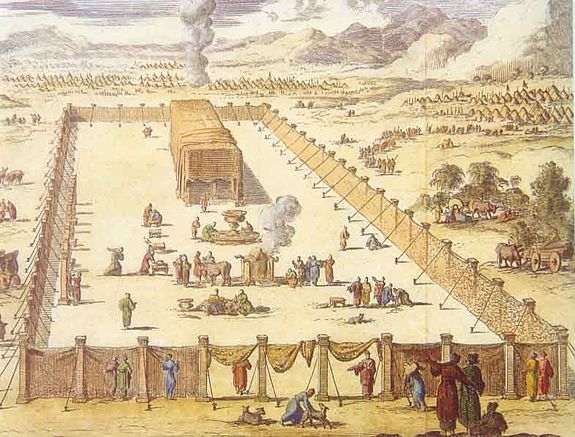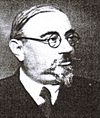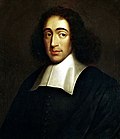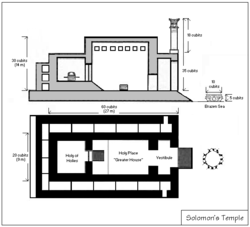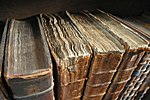Terumah (parashah)
[3] In the first reading, God instructed Moses to tell all Israelites whose heart so moved them to bring gifts of gold, silver, copper, colored yarns, fine linen, goats' hair, tanned ram skins, acacia wood, oil, spices, lapis lazuli, and other fine stones to make a sanctuary—the Tabernacle (Mishkan, מִּשְׁכָּן)—and its furnishings, so that God could dwell among them.
[9] God instructed them to make the Tabernacle of ten curtains of fine twisted linen, of blue, purple, and crimson yarns, with a design of cherubim worked into them.
[15] God instructed them to make a screen for the entrance of the Tent, of colored yarns, and fine twisted linen, done in embroidery and supported by five posts of acacia wood overlaid with gold.
[16] In Exodus 26:31 God instructed Moses: "And you shall make a [brocade] curtain of blue [woollen threads], and purple, and crimson, and fine twined linen of cunning work, with cherubims shall it be made."
The Sages of Israel relayed an oral tradition that the sense here is to the work of an artisan skilled in motifs and woven directly unto the fabric from the loom, rather than being embroidered.
"[47] Reading God's words in Exodus 25:2, "accept gifts for Me from every person whose heart so moves him," the Mekhilta of Rabbi Simeon deduced that each and every Israelite was so rich from having stripped the Egyptians (as reported in Exodus 12:36) that each Israelite had the wherewithal to erect the Tent of Meeting, with all its vessels, all of its golden hooks, boards, wooden bars, columns, and pedestals.
[49] The Rabbis taught in a Baraita that the turquoise wool (techeilet, תְכֵלֶת) listed in Exodus 25:4 came from an animal called a chilazon that resembled the sea in color and a fish in shape, that appeared once every 70 years, and whose blood was used to dye the expensive blue thread.
For initially, the words of Exodus 15:17, "You bring them and plant them in the mountain of Your inheritance, the place that You, O Lord, have made for You to dwell in," indicated that God’s original intention was to build a Temple for the Jewish people after they had entered the Land of Israel.
The Gemara resolved this apparent contradiction by teaching that Exodus 25:10 refers to a time when the Jewish people did God's will, and they are credited with building the Ark of the Covenant.
Similarly, God loved Israel, bringing the Israelites to Mount Sinai, and giving them the Torah, but after only 40 days, they sinned with the Golden Calf.
[85] Rav Kattina said that whenever the Israelites came up to the Temple on a Festival, the priests would pull back the curtain and show them the Cherubim, whose bodies were intertwined with one another (in an embrace).
Resh Lakish taught that when the Romans entered the Temple (during its destruction) and saw the Cherubim whose bodies were intertwined with one another, they carried them out and mocked the Israelites, saying that a people whose blessings and curses God supposedly fulfilled occupied themselves with such (sensuous) things.
The Gemara further explained that according to Rabbi Judah's theory, before the Philistine coffer came, the Torah scroll was placed on a ledge projecting from the Ark.
Rabbi Johanan taught that it is forbidden, however, to teach this to people who through ignorance are careless in the observance of the laws (as it might deter them from further Torah study).
[55] Issi ben Judah listed the words "like almond blossoms" in Exodus 25:34 among five passages in the Torah whose grammatical structures are unclear.
[105] Rav Ashi taught that one could derive from the term עַשְׁתֵּי-עֶשְׂרֵה, ashtei-esreih, or "eleven," in Exodus 26:7 that one who adds to God's word actually subtracts from it.
Rabbi Levi taught that the Israelites cut the trees down in Magdala of the Dyers near Tiberias and brought them with them to Egypt, and no knot or crack was found in them.
The Gemara explained that according to Rabbi Jose's reading, the words of Exodus 27:18, "And the height five cubits," meant from the upper edge of the altar to the top of the hangings.
Similarly, Maimonides taught, God instituted many laws as temporary measures, as it would have been impossible for the Israelites suddenly to discontinue everything to which they had become accustomed.
But in the Divine plan, prayer and supplication can be offered everywhere and by every person, as can be the wearing of tzitzit (Numbers 15:38) and tefillin (Exodus 13:9, 16) and similar kinds of service.
[127] Robert Alter reported the strong scholarly consensus that Exodus 25–27 is the work of the Priestly source (P), reflecting P's special fascination with the details of cultic paraphernalia.
Thus unlike religious edifices today, which are places for people to enter and worship, the Tabernacle was like temples and shrines in the ancient world, which were considered earthly residences for deities (see Exodus 25.8), off-limits for most humans—costly, well-furnished structures befitting their divine occupants.
[30] Nahum Sarna observed that iron is notably absent, either on account of its great rarity at the time or because its use for more efficient weapons of death made it incompatible with the spiritual ends that the Tabernacle served.
Sarna observed that the verb "to dwell" is not the common Hebrew y-sh-v but the rarer sh-k-n, which conveys the idea of temporary lodging in a tent as in the nomadic lifestyle.
Rather, Sarna argued, the Tabernacle made perceptible and tangible the conception of God's immanence, that is, of the indwelling of the Divine Presence in the Israelite camp.
Wells noted that several ancient Near Eastern texts support this second option, referring to instances where gods revealed models of or plans for religious objects to those responsible for building them.
[140] Friedman observed that the cubit-and-a-half width of each board used to construct the Tabernacle described in Exodus 26:16 is strange, as he presumed that ancient Israelites carried a one-cubit-long measuring string.
Friedman concluded from this that the author of the Priestly source thought to have written this material must have lived before Nebuchadnezzar II destroyed Solomon's Temple in 587 BCE.
[141] Mark Smith saw in the word for these boards, קְּרָשִׁים, kerashim, a connection to the dwelling place of the Canaanite god El, called krsh, for "tabernacle" or "pavilion."
[157] The Temple was built from stone made ready at the quarry, and no hammer, ax, or other iron tool was heard at the building site.



